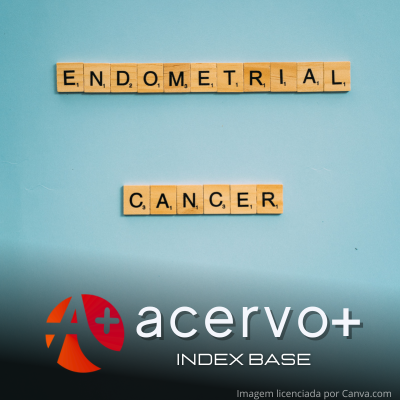Dispositivo Intrauterino para proteção de endométrio contra câncer
##plugins.themes.bootstrap3.article.main##
Resumo
Objetivo: Realizar uma revisão abrangente da literatura sobre o câncer de endométrio e a relação com o Dispositivo Intrauterino (DIU) liberador de Levonorgestrel, avaliando seu potencial como fator protetor na prevenção desta neoplasia. Métodos: Foi realizada uma pesquisa exploratória de caráter quantitativo, do tipo revisão de literatura nas bases de dados PubMed Medline, BVS, ScienceDirect (Elsevier) e Portal de Periódicos CAPES. Termos usados: "LNG-IUD", "Endometrial cancer", "Cancer risk", "Levonorgestrel", "Dispositivos Intrauterinos", "Neoplasias do Endométrio", “Endométrio” e “Levanogestrel”. Foram selecionados artigos relevantes e disponíveis para acesso público. Resultados: No PubMed, dez artigos indicaram que o DIU hormonal provoca alterações no endométrio, reduzindo significativamente o sangramento e a proliferação celular. No Portal de Periódicos CAPES, dez artigos mostraram que o DIU está associado a menor incidência de câncer endometrial, especialmente em mulheres obesas. Na BVS, quatro artigos confirmaram a eficácia do DIU hormonal no tratamento de hiperplasia endometrial, sendo uma alternativa eficaz aos progestágenos orais. Considerações finais: O Dispositivo Intrauterino liberador de Levonorgestrel pode desempenhar um papel importante na prevenção e tratamento do câncer de endométrio, reduzindo o risco de câncer e promovendo a regressão da hiperplasia endometrial.
##plugins.themes.bootstrap3.article.details##
Copyright © | Todos os direitos reservados.
A revista detém os direitos autorais exclusivos de publicação deste artigo nos termos da lei 9610/98.
Reprodução parcial
É livre o uso de partes do texto, figuras e questionário do artigo, sendo obrigatória a citação dos autores e revista.
Reprodução total
É expressamente proibida, devendo ser autorizada pela revista.
Referências
2. BERNARD L, et al. The levonorgestrel intrauterine system (LNG-IUS) for prevention of endometrial cancer in women with obesity is cost effective. FREEDOM, 2021; 162(2): 300-301.
3. BRASIL. Hiperplasia endometrial e câncer do endométrio. São Paulo: Federação Brasileira das Associações de Ginecologia e Obstetrícia (Febrasgo); 2018. Disponível em: https ://docs.bvsalud.org/biblioref/2019/12/1046498/femina-2019-472-105-109.pdf. Acesso em: 5 abr. 2024.
4. CORTESSIS VK, et al. Intrauterine Device Use and Cervical Cancer Risk: A Systematic Review and Meta-analysis. Journal of Obstetrics & Gynecology, 2017; 130(6): 1226-1236.
5. CROSBIE EJ, et al. Endometrial cancer. Lancet. 2022; 399(10333): 1412-1428.
6. DERBYSHIRE AE, et al. PROgesterone Therapy for Endometrial Cancer Prevention in Obese Women (PROTEC) Trial: A Feasibility Study. Cancer Prevention Research. Filadélfia, 2021; 14(2): 263-274.
7. DHAR KK, et al. Is levonorgestrel intrauterine system effective for treatment of early endometrial cancer? Report of four cases and review of the literature. Gynecologic Oncology. 2005; 97(3): 924-927.
8. EDELMAN A e KANESHIRO B. Contraception: Counseling for females with obesity. UpToDate, 2024.
9. ELASSALl GM, et al. Levonorgestrel-releasing intrauterine system versus systemic progestins in management of endometrial hyperplasia: A systemic review and meta-analysis. Journal of Gynecology Obstetrics and Human Reproduction, 2022; 51(8): 102432.
10. FELIX AF, et al. Intrauterine devices and endometrial cancer risk: A pooled analysis of the Epidemiology of Endometrial Cancer Consortium. International Journal of Cancer, 2015; 136(5): 989-1243.
11. GALLOS ID, et al. LNG-IUS versus oral progestogen treatment for endometrial hyperplasia: a long-term comparative cohort study. Human Reproduction, 2013; 28(11): 2966-2971.
12. GOLDSTUCK ND. The levonorgestrel-releasing intrauterine system 52 mg as a contraceptive versus a therapeutic: essential differences and perspectives. The European Journal of Contraception & Reproductive Health Care, 2023; 28(3): 177–183.
13. GOMPEL A. Progesterone and endometrial cancer. Best Practice & Research Clinical Obstetrics & Gynaecology, 2020; 69: 95-107.
14. GUTTINGER A e CRITCHLEY HOD. Endometrial effects of intrauterine levonorgestrel. Contraception, 2007; 75(6): 93-98.
15. HIRATA T, et al. Safety and efficacy of levonorgestrel-releasing intrauterine device in the treatment of atypical endometrial hyperplasia and early endometrial cancer. The Journal of Obstetrics and Gynaecology Research, 2022; 48(12): 3219-3225.
16. JAREID M, et al. Levonorgestrel-releasing intrauterine system use is associated with a decreased risk of ovarian and endometrial cancer, without increased risk of breast cancer. Results from the NOWAC Study. Gynecologic Oncology, 2018; 149(1): 127-132.
17. MACKINTOSH ML e CROSBIE EJ. Prevention Strategies in Endometrial Carcinoma. Current Oncology Reports, 2018; 20(11): 101.
18. MADDEN T. Intrauterine contraception: Candidates and device selection. UpToDate, 2024.
19. MARKOWSKA A et al. Endometrial Cancer Management in Young Women. Cancers, 2022; 14(8): 1922.
20. MEER ACL e HANNA LS. Development of endometrioid adenocarcinoma despite Levonorgestrel-releasing intrauterine system: a case report with discussion and review of the RCOG/BSGE Guideline on the Management of Endometrial Hyperplasia. Clinical Obesity, 2017; 7(1): 54-57.
21. MITTERMEIER T e FARRANT C, et al. Levonorgestrel-releasing intrauterine system for endometrial hyperplasia. Cochrane Database of Systematic Reviews, 2020; 6(9).
22. MORELLI M, et al. Efficacy of the levonorgestrel intrauterine system (LNG-IUS) in the prevention of atypical endometrial hyperplasia and endometrial cancer: retrospective data from selected obese menopausal symptomatic women. Gynecological Endocrinology, 2013; 29(2): 156-159.
23. MUECK AO e SEEGER H, et al. Hormonal contraception and risk of endometrial cancer: a systematic review. Endocrine-Related Cancer, 2010; 17(4): 263-271.
24. NOVIKOVA OV, et al. Live births and maintenance with levonorgestrel IUD improve disease-free survival after fertility-sparing treatment of atypical hyperplasia and early endometrial cancer. Gynecologic Oncology. Elsevier, 2021; 161(1): 152-159.
25. SILVA FC, et al. Avaliação da influência do uso de métodos contraceptivos sobre os resultados dos esfregaços de Papanicolaou. Acta Scientiarum. Health Sciences, 2006; 28(1): 65-70.
26. SOINI T, et al. Cancer risk in women using the levonorgestrel-releasing intrauterine system in Finland. Journal of Obstetrics & Gynecology, 2014; 124(2-1): 292-299.
27. TANIGUCHI I, et al. Weight-Loss Interventions and Levonorgestrel Intrauterine System Implantation for Early-Stage Endometrial Cancer and Atypical Endometrial Hyperplasia to Reduce Perioperative Risk of Severely Obese Patients. Gynecology and Minimally Invasive Therapy, 2023; 12(3): 175-178.
28. WAN YL e HOLLAND C. The efficacy of levonorgestrel intrauterine systems for endometrial protection: a systematic review. Climacteric, 2011; 14(6): 622-632.
29. WASHINGTON CR, et al. Knowledge of endometrial cancer risk factors in a general gynecologic population. Gynecologic Oncology, 2020; 158(1): 137-142.

